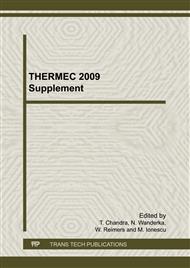p.521
p.527
p.533
p.539
p.545
p.551
p.556
p.562
p.568
Residual Stress Evaluation of Railway Wheels by X-Ray Diffraction and Finite Element Method
Abstract:
X-ray stress measurement is useful for determining, in a non-destructive manner, the surface stresses of engineered parts. However, the railway wheels cannot measure because this it is very large. So it should be measured using a scaled-down model. The problem is, however, how the stress release should be considered. In this analysis, the finite element method (FEM) was applied to estimate the initial stress state using stresses released after cutting a sample obtained by the X-ray method. Railway wheels were studied in this experiment. In the early 1990s, several railroads in the northeast of the U.S.A. experienced extensive cracking in the wheels of the commuter trains. Residual stresses in the hoop direction play an important role in mechanism fatigue damage. This paper will discuss about residual stress in the hoop direction in manufactured wheels. The results of FEM analysis and the X-ray diffraction method confirms that these methods can be used to evaluate the residual stress of the hoop direction. There is very good quantitative agreement between the simulated and measured stress distributions. It can be suggested that guessing guess stress release and the redistribution by the FEM analysis is possible. The residual hoop stress of the unused wheel presumed by this research has the residual stress of high compression in the wheel at the center of the rim up to 40mm depth. It is very safe because the residual stress state is compressive even when a crack occurs, and obstructs the crack’s progress. If a crack occurs by any chance, the stress state can obstruct the crack’s progress.
Info:
Periodical:
Pages:
545-550
Citation:
Online since:
January 2010
Price:
Сopyright:
© 2010 Trans Tech Publications Ltd. All Rights Reserved
Share:
Citation:


